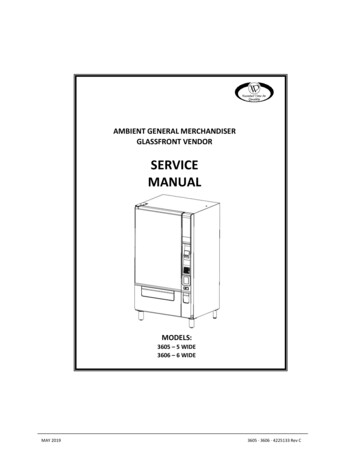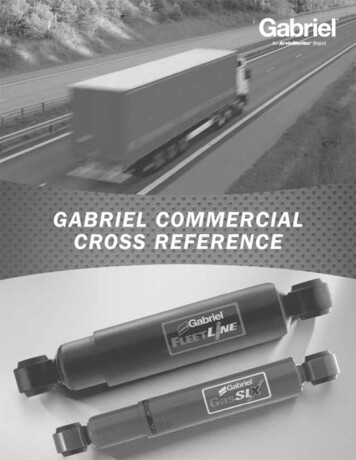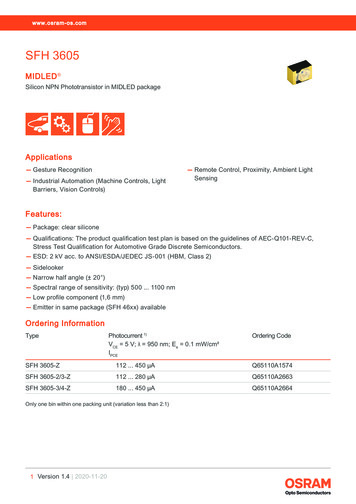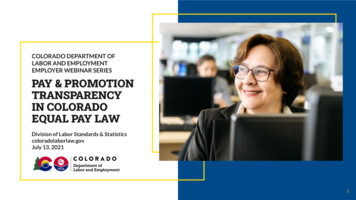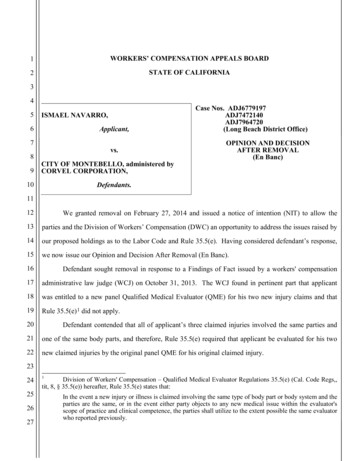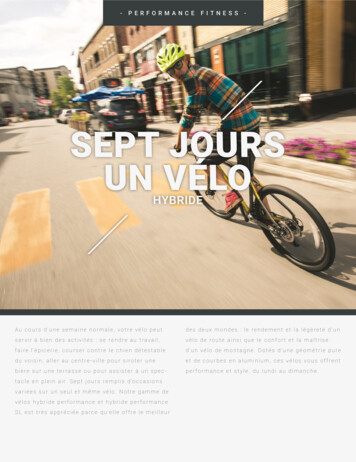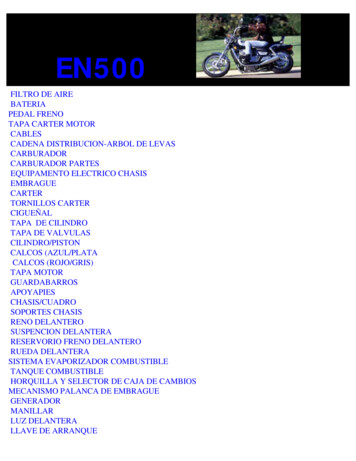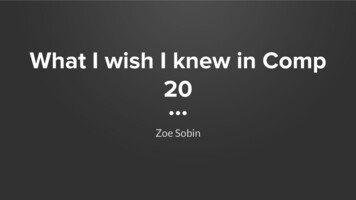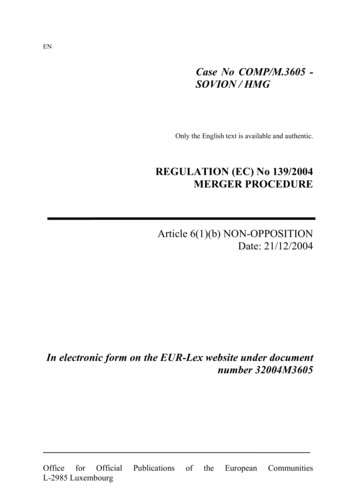
Transcription
ENCase No COMP/M.3605 SOVION / HMGOnly the English text is available and authentic.REGULATION (EC) No 139/2004MERGER PROCEDUREArticle 6(1)(b) NON-OPPOSITIONDate: 21/12/2004In electronic form on the EUR-Lex website under documentnumber 32004M3605Office for OfficialL-2985 LuxembourgPublicationsoftheEuropeanCommunities
COMMISSION OF THE EUROPEAN COMMUNITIESBrussels, 21.12.2004SG-Greffe(2004) D/206055In the published version of this decision, someinformation has been omitted pursuant to Article17(2) of Council Regulation (EEC) No 139/2004concerning non-disclosure of business secrets andother confidential information. The omissions areshown thus [ ]. Where possible the informationomitted has been replaced by ranges of figures or ageneral description.PUBLIC VERSIONMERGER PROCEDUREARTICLE 6(1)(b) DECISIONTo the notifying party :Subject:Case No COMP/M.3605 SOVION/HMGNotification of 18/11/2004 pursuant to Article 4 of Council RegulationNo 139/200411.On 18/11/2004, the Commission received a notification of a proposed concentrationpursuant to Article 4 of Council Regulation (EC) No 139/2004 by which theundertaking Sovion (“Sovion”, The Netherlands) acquires within the meaning ofArticle 3(1)(b) of the Council Regulation control of the whole of the undertakingHendrix Meat Group (“HMG”, The Netherlands) by way of purchase of shares.2.After examining the notification, the Commission has concluded that the notifiedoperation falls within the scope of the Merger Regulation and that it does not raiseserious doubts as to its compatibility with the common market and the EEAAgreement.I.THE PARTIES3.Sovion (formerly known as Best Agrifund) is active in the slaughtering of pigs andcattle, the processing, production and sale of meat products and processing of abattoirby-products and the production and sale of products made from abattoir by-products.Sovion is mainly active in the Netherlands, Germany and Belgium.4.All the shares in Sovion are (indirectly) held by Noordbrabantse ChristelijkeBoerenbond, Rooms-Katholieke Vereniging van Boeren en Tuinders-Ontwikkeling("NCB"). This organisation has the same management and, through its participation in1OJ L 24, 29.1.2004 p. 1.Commission européenne, B-1049 Bruxelles / Europese Commissie, B-1049 Brussel - Belgium. Telephone: (32-2) 299 11 11.
the regional chapters,the tie" ("ZLTO"). ZLTO is an association of farmers and agri- andhorticulturalists, including approximately 3,000 pig farmers. Thus, the membersof ZLTO through their representatives in the management of NCB and the generalmembers meeting of NCB, ultimately control Sovion.2 It is worth mentioning here thatNCB has expressed its support for the proposed transaction3.5.Hendrix Meat Group is active in the slaughtering of pigs and the processing,production and sale of meat products. HMG’s main geographic focus is theNetherlands4.II. THE OPERATION AND THE CONCENTRATION6.The transaction consists of the proposed acquisition by Sovion of sole control of allissued shares of the corporate entities belonging to HMG. At closing, the Sovion groupwill own 100% of the shares in the HMG entities. The proposed corporate structure ofthe Sovion group is not yet known.7.Therefore, the operation constitutes a concentration within the meaning of Article3(1)(b) of the Merger Regulation.III. COMMUNITY DIMENSION8.The undertakings concerned have a combined aggregate world-wide turnover of morethan EUR 5 billion (Sovion [ ] and HMG [ ] in 2003). Each of Sovion and HMGhave a Community-wide turnover in excess of EUR 250 million (Sovion [ ] andHMG [ ] in 2003), but they do not achieve more than two-thirds of their aggregateCommunity-wide turnover within one and the same Member State. The notifiedoperation therefore has a Community dimension.IV. COMPETITIVE ASSESSMENTA.Relevant markets9.The parties claim that several stages can be distinguished during the processing of pigs.Once purchased on the market for live pigs (upstream market), the pigs areslaughtered. At this first processing stage ("Abattoir-stage") pigs are "divided" intocarcasses and abattoir by-products (such as blood, bones, pigskin, fat and bowel234Sovion has four direct subsidiaries: two active companies, Bestmeat Company B.V. ("Bestmeat") andSobel N.V. ("Sobel"), and two shell/holding companies, Chemson B.V. and Termochem Beheer B.V.Bestmeat is engaged in the meat activities through its three subsidiaries CG Nordfleisch A.G.("Nordfleisch") and A. Moksel AG ("Moksel") in Germany and Dumeco B.V. ("Dumeco").[ ] Meeting of July 12, 2004.HMG consists of five companies: Smits Emmen B.V., Hendrix' Vlees Druten B.V., Murris Meppel B.V.,Hendrixbacon UK Ltd.(UK) and Drucar S.r.l. (Italy). Hendrix' Vlees Druten B.V. has two subsidiaries:Hendrix Meat Group B.V. and Murris Varkens B.V. All the Dutch companies are member of the HendrixMeat Group C.V. (a Dutch limited partnership), in which all the activities of its members are united.2
packages). The carcasses may be sold to third parties or may be divided into "technicalparts". Subsequently, the technical parts are either sold to a variety of customers – suchas industrial processors (e.g. the sausage-industry, pre-packagers, etc.), de-boningcompanies, traders, butchers and also sometimes to retailer groups that de-bone themeat for own purposes – or used for further de-boning or processing by theslaughterhouse operators ("Processing-stage"). De-boned or processed pig meat is thensold to supermarkets, industrial processors, butchers or caterers.10. Broadly speaking, the Parties are active in three sectors/markets:1. the upstream markets on which live pigs are purchased and slaughtered;2. the downstream markets on which fresh meat is sold; and3the downstream markets on which the abattoir by-products are sold.11. These sectors/markets can be further delineated into separate product markets, asdescribed below.1.Purchasing of live pigs and sows for slaughtering12. Both Parties are active in slaughtering of live pigs, and are therefore active in themarket for purchasing of live pigs for slaughtering. Sovion is active in slaughtering ofpigs and sows through ten slaughterhouses located in the Netherlands or in the westernpart of Germany and slaughtered a total of [5-10] million pigs in 2003. HMG is activein slaughtering through two slaughterhouses located in the Netherlands ( in Druten andin Meppel). A third slaughterhouse located in Emmen was closed in April 2003.Therefore the competitive assessment has not taken this slaughterhouse into account.HMG slaughtered a total of [0-5] million pigs in 2003.a)Product market13. The Commission has previously defined a separate product market for the slaughteringof live pigs5. Moreover, the Commission has in the past further delineated the marketfor slaughtering of live pigs into slaughtering of pigs on the one hand and slaughteringof sows on the other. This is based on the fact that pigs and sows for slaughtering differgreatly in weight. The Commission has found that the slaughtering of pigs and sowsrequires a different technical design of the slaughter line since sows are much heavierat the time of slaughter and therefore require different processing lines at theslaughterhouse. Switching from pigs to sows is in principle possible but generallytakes time and implies non-negligible switching costs.14. The Parties contest this further delineation and disagree that the slaughtering of livepigs and the slaughtering of sows constitute separate markets. They claim that, bothfrom the perspective of the slaughterhouse and from the perspective of the downstreammarket customers, live sows and live pigs and meat from sows and pigs respectivelyare substitutes. In addition, they explain that recent technical developments have madeit possible to use the same slaughter line for both live pigs and sows. The Parties alsoadd that both meat from sows and pigs are suitable for the production of sausages madefrom pork. Sow meat is mainly used for the production of sausages but sow meat isalso sold as fresh pork.5Commission decisions COMP/M.1313 – Danish Crown/Vestjyske Slagterier; COMP/M.2662 – DanishCrown/Steff-Houlberg and COMP/M.3337 – Best Agrifund/Nordfleisch3
15. The market investigation has nevertheless largely confirmed the market definitionadopted by the Commission in past cases. Most respondents claim that pigs and sowsconstitute distinct markets, due to the characteristics of sows at time of slaughtering.Although very few slaughterhouses can use the same slaughter lines, thanks to recenttechnological improvements, in most cases switching costs remain high. They alsoclaim that the downstream markets are different, as meat from pigs and meat fromsows are mostly used for different meat end-products.16. Therefore for the purpose of this case, the Commission has defined two differentmarkets, one for the slaughtering of sows and one for the slaughtering of pigs.b)Geographic market617. In previous decisions concerning the purchasing and slaughtering of live pigs, theCommission has considered the geographic market as national in scope. However, in arecent decision concerning the German market7 the Commission left the precise scopeof the geographic market open. In the same decision, the Commission also indicatedthat in the German market live pigs are generally transported over a distance of 200 to300 km.18. The Parties argue that this is also the case for the Netherlands. Consequently, theParties argue, for a country like the Netherlands this would mean that the market is notnational but – at least – regional and would include at least the western part ofGermany, Belgium, Luxembourg and the northern part of France.19. The parties also claim that the market may be even wider, as a considerable number oflive pigs are transported from the Netherlands to Italy, Spain or Southern Germany forslaughtering. The parties also indicate that about 10-15% of Dutch live pigs areslaughtered outside the Netherlands. Besides, the parties highlight that purchasingprices of live pigs in the Netherlands are strongly linked to those in Germany and viceversa, which is considered as evidence of the fact the market is wider than national.20. Finally, the parties claim that transportation costs are very low and have only marginalimpact on the price of pigs for slaughtering. Consequently, farmers do not face hightransport costs and can ship their pigs to various slaughterhouses within relatively longdistances. Transport costs represents only 1% of the price of a pig (average 90 kg)purchased at a distance of 50 km. Each further 50 km transport costs [0.15-0.25],which represents [0-0.2] % of the purchase price of a pig. These figures have beenlargely confirmed by the market investigation.21. On the basis of the foregoing arguments, the parties submit that the geographic scopeof the market for the purchase of live pigs for slaughtering is, at least, a radius of 200300 km around each pig production area.22. Whilst the Parties are convinced of the validity of this proposed market definition, theyhave also submitted evidence and data in support of an alternative geographic marketdefinition.6For the purpose of the geographic market definition, pigs and sows will be considered together, as thesame analysis applies for both product markets. Throughout this section of the decision “live pigs” willrefer to both pigs and sows.7See Case No Comp/M.337, Best Agrifund/Nordfleisch.4
23. The Parties submit that, although pigs can be easily transported for longer distances,the vast majority of live pigs for slaughtering are purchased and transported toslaughterhouses within a radius of 150 km.24. The Parties submit that pig farms (selling pigs for slaughter) are mainly concentrated inthree regions in the Netherlands (Twente, the Achterhoek and Noord-Brabant and thenorthern part of Limburg).25. The Parties have submitted calculations on the basis that one large pig farm isestablished in the centre of those regions. The cities in the middle of those regionsrepresent the place of business of that large pig farm. For Twente this is Enschede, forthe Achterhoek this is Doetinchem and for Noord-Brabant and the northern part ofLimburg this is Eindhoven. The three 150km radii include also slaughterhouses locatedin the western regions of Germany and to a much lesser extent in northern Belgium.26. While the market investigation has largely confirmed the 150 km radius and theconcentration of pig farming in the three above mentioned regions of the Netherlands,very few respondents have claimed that German slaughterhouses lying within the 150km radius only exert limited competitive constraints on Dutch slaughterhouses due tovarious factors, which would allegedly limit the amount of exports from theNetherlands into Germany and make them economically suboptimal and also moreunpredictable.27. These respondents, notably Dutch pig farmers and traders, have highlighted inparticular three elements:– differing preferences on the Dutch and German market. Dutch pig farmers wouldbreed different types of pigs, one destined for Dutch slaughtering and one destinedfor export to Germany. The German-oriented pig would be heavier and slightlydifferently shaped, so as to provide certain types of “cuts" suitable for the Germanmarket. This means, the argument goes, that it is not easy to export to Germany apig originally destined for the Netherlands and vice versa.– exporting pigs to Germany would require a great deal of specific veterinaryrequirements which raise costs (blood sampling carried out at the farm rather than atthe Dutch slaughterhouse of destination, mandatory presence of one veterinarywhen pigs are loaded on the trucks etc.). Moreover, it would appear that, due toregulatory requirements, traders exporting to Germany can only do one pick-up stopat one farm (or collecting point), rather than three as allowed for pigs destined forDutch slaughterhouses. As a result, pigs to Germany proceed mainly from bigfarms, whereas small farmers sell most of their pigs within the Netherlands.– exports to Germany (or elsewhere) would be, to some extent, unpredictable, due tosudden disease outbreaks (porcine fever, MPA, Dioxin, FMD etc). During theseoutbreaks, borders are closed and exports prohibited.28. According to these third parties, these factors contribute to raising barriers to export byraising switching costs. Although on average approximately 13 % of Dutch pigs areexported, switching is not possible and involves substantial risks and costs.29. Moreover, recent trends would appear to indicate that slaughterhouses tend to negotiatelonger supply deals with farmers, which would further reduce the possibility of easyswitching for farmers.5
30. With a view to assessing the validity and the relevance of these claims, theCommission has conducted a supplementary investigation with the Parties and with therelevant third parties (Dutch pig suppliers and traders and German pig suppliers andslaughterhouses).31. In the course of the additional market investigation, the Parties have argued that theonly difference between German-oriented pigs and Dutch-oriented pigs is their weight,German pigs being approximately 2 kg heavier than Dutch pigs. As pigs at the end ofthe fattening stage grow by approximately 750 grams per day, farmers would only haveto wait for two more days before pigs reach the ideal weight for export to Germany.This was confirmed by German pig farmers and slaughterhouses.32. The parties also stress that there is no significant genetic difference between pigsslaughtered in the Netherlands and those slaughtered in the Western and Northern partof Germany. This has been confirmed by third parties, among which Dutch andGerman pig suppliers and traders and German slaughterhouses and by Hypor, a leadingpig genetics company.33. As regards special veterinary requirements for exports, the parties have submitted thatall live pigs for slaughtering have to be examined irrespective of where they areslaughtered. However, the presence of a veterinarian is required at the farm or at theexport collection point when pigs are exported. The extra costs incurred as a result ison average 1-1.25 per pig, which represents approximately 1% of the purchase priceof pig. These figures have been confirmed by third parties contacted by theCommission in the course of the investigation.34. In practice, the Parties have argued and third parties have confirmed, these extra costsincurred for export-related requirements are compensated by the traditionally higher(owing mainly to shortage of pigs for slaughtering) purchasing price on the Germanmarket.35. The Parties have confirmed the one-pick up stop rule, but have argued that thecollection centres are geographically spread all over the relevant area in Neerkant,Lieshout, Nispen, Lemelerveld, Wijnjewoude, Lunteren en Weel. Bringing pigs tothese collection points is easy. Thus, the fact that traders exporting to Germany canonly do one pick-up stop and do not go to individual small farms, has a very marginalimpact, if any, on pig farmers, as collection points are numerous and, furthermore,export certificates are issued for free at the various collection points.36. As regards pricing terms, the Parties state that pig prices are solely determined by theprice prevailing on the international meat market. If the Parties were to attempt todepress purchasing prices by a small but significant amount (i.e. 5 to 10%) they wouldimmediately face a sharp decrease in the amount of pigs supplied to theirslaughterhouses. A high percentage of those supplies would be exported to Germanslaughterhouses.37. Furthermore, German prices for the purchasing of live pigs are traditionally higher thanDutch prices. However, the two are strongly correlated, i.e. they tend to move inparallel in the medium-long term. The Parties have submitted evidence and datashowing that there exists a close relation between the German-Dutch price spread andthe exports of pigs to Germany. When prices in the Netherlands decrease, or the pricein Germany rises (i.e. the spread is wider), exports of live pigs to Germany increase. Inother words, pig farmers can switch from Dutch slaughterhouses to German ones in thepursuit of the best pricing terms.6
38. This has been confirmed by German and Dutch pig suppliers and traders and Germanand Dutch slaughterhouses, some of which have also provided evidence and data insupport of this argument.39. As regards the claim that slaughterhouses negotiate longer supply deals with farmers,thus reducing farmers flexibility to switch in response to changes in purchasing prices,the Parties have indicated that exclusive dealing and long-term contracts are not afeature of the market for pigs for slaughter.40. Specifically with regard to the Parties’ operations, the vast majority of HMG’ssuppliers sell on the basis of the house price. As to the others, HMG has a one-yearrelationship with several suppliers on the basis of verbal gentleman’s agreements. Withrespect to Sovion, the majority of suppliers [ ] supply purely on the basis of the"house" price set weekly by Sovion. [ ] The rest of suppliers supply regularly toSovion on the basis of the average house price, rolling over a [ ]-week period ("trendprice") which gives them a more stable price than the weekly fixed house price. Theselatter suppliers have usually "one-year" delivery contracts with Sovion. This contractassures the payment of the trend price if a pig farmer commits to the delivery of [ ] toSovion and if he submits forecasts for the next [ ] weeks. The pig farmer is granted abonus of maximum [ ] per pig, when the forecasts prove accurate. Disrespect of thecontract is not sanctioned in any way, the contract can be terminated at will at the endof the [ ]-week delivery period.41. Against this background, the Parties argue that switching costs for suppliers arenegligible (i.e. no fines are attached to disrespect or termination of the contract and thepayment of the house price is guaranteed, even when the trend price is not due) and itis relatively common for suppliers to switch to exporting in response to higher prices inGermany.42. This was confirmed by third parties. In particular the Parties’ claim as regards the closelink between the Dutch and the German market, is also confirmed by the CentralOrganisation for the Dutch Meat Sector (Centrale Organisatie voor de Vleessector(COV), which has indicated that the Dutch and the German markets are stronglyinterrelated.43. Finally, the Commission has concluded that export data indicate that sporadic(however frequent) disease outbreaks and the resulting border closures have notimpeded large amounts of pigs from being exported from the Netherlands. Moreover,in case of animal diseases certain areas may be closed temporarily for the export ofpigs. The closed areas can be municipalities, provinces which do not automaticallycoincide with national borders. Therefore, these situations also affect trade within theNetherlands, for example leading to the situation that a farmer cannot supply its regularDutch slaughterhouse as a result of a transport prohibition. Therefore disease outbreakscannot be the determining factor when defining the geographic scope of a market.44. On the basis of all the foregoing, the Commission has concluded that, for the purposeof the competitive assessment of this case, the appropriate geographic marketdefinition consists of the 150 km radii around the three main pig-farming areas in theNetherlands. As mentioned (see footnote 6), the same geographic market definitionapplies for the purchasing of live sows for slaughtering.7
c)Competitive assessment45. Pursuant to the transaction, Sovion would acquire control of the two slaughterhousescurrently belonging to HMG: one located in Druten (capacity of [0.5-1 million] pigsper year), and one located in Meppel (capacity of [1-1.5] million pigs per year).46. As mentioned, Dutch pig farms (selling pigs for slaughtering) are concentrated in threeregions (Twente, the Achterhoek and Noord-Brabant and the northern part of Limburg)whose main cities are respectively Enschede, Doetinchem and Eindhoven.47. The combined market shares of Sovion and HMG in the markets for the purchasing oflive pigs for slaughtering constituted by these areas are shown in the table below:Purchase and slaughter of pigs 2003SovionHMGTotal150 km range Enschede[5-15]%[0-10]%[10-20]%150 km range Eindhoven[20-30]%[0-5]%[20-30]%150 km range Doetinchem[15-25]%[0-10]%[20-30]%48. In these markets, the Parties purchase live pigs from farmers. Pigs are then processedat the parties’ slaughterhouses. If the parties were in a position to exert market power,this would take the form of buying power vis-à-vis suppliers of live pigs. As a result,the parties may attempt to depress prices when purchasing live pigs for slaughtering.49. Although the Parties would be, as a result of the transaction, the largest player in theDutch market and one of the major players in the northern European market, themarket shares within the geographical markets relevant for the assessment of thecompetitive impact of the case remain relatively low and far below market shareswhich may be indicative of dominance. Moreover, the markets remain sufficientlyfragmented, with the Parties’ main competitors (such as Dreckmann, Westfleisch andHilckmann8) holding market shares ranging between 4% and 16% (depending on thearea). The remainder of the market is covered by slaughterhouses with smaller but stillsignificant capacity (such as Compaxo, Westvlees, Slachtuis Groenlo, Goossens,Tummel and Hofman, each with capacity of [500,000-1,000,000] pigs/year).50. Moreover, the parties also submit that most of their competitors, both in theNetherlands and in Germany, operate below full capacity and have provided data insupport of this claim. The average spare capacity appears to be 12% in theNetherlands, 14% in Belgium and 28% in the western regions of Germany. This waslargely confirmed by the market investigation, both for Dutch and for Germanslaughterhouses. The market investigation has also confirmed that even thoseslaughterhouses which are currently working at or close to full capacity may, if8It has to be mentioned that Toennies, (Germany) has slaughterhouses with very large capacity lyingbeyond but very close the 150km radii. Its slaughtering capacity has not been taken into account in thecalculation of market shares.8
necessary, add extra shifts at relatively low cost, thereby effectively raising theirslaughtering capacity.51. It can therefore be reasonably argued that the margin for manoeuvre of the Parties todetermine prices for the purchase of live pigs is greatly diminished, as pig farmers canreadily find alternative outlets for their supplies by selling to other slaughterhouses,within the 150 km radius, both in the Netherlands and in Germany.52. Concerning the market for the purchasing of sows for slaughtering , the combinedmarket shares of the Parties in the relevant geographic markets are indicated in thetable below:Purchase and slaughter of sows 2003Sovion9HMGTotal150 km range Enschede[0-10]%[0-5]%[5-15]%150 km range Eindhoven[5-15]%[0-10]%[15-20]%150 km range Doetinchem[0-10]%[0-5]%[5-15]%53. Therefore, in these markets, the combined market shares of the Parties are considerablylower than for pigs. The competitive assessment for pigs thus applies a fortiori forsows.54. On the basis of the foregoing, notably the relatively low market shares in the relevantgeographic markets, combined with the existing spare capacity, it can be concludedthat the proposed transaction does not give rise to competition issues in the market forpurchasing live pigs and sows for slaughtering.2.Sales of fresh meat55. Both Sovion and HMG are active in the sale of meat to various categories ofcustomers. The Parties have identified four product markets to be considered affectedas a result of the concentration. These markets are the (i) sale of fresh pork tosupermarkets, (ii) the sale of fresh beef to supermarkets, (iii) the sale of fresh pork toindustrial processors and (iv) the market for “convenience products”. The Commissionhas investigated the affected markets identified by the Parties and in addition hasdecided to discuss certain aspects of (v) the processed pork meat market. No otheraffected market has been identified by the market investigation.(i) Sales of fresh pork to supermarketsProduct market9Sovion’s market share includes also 100% of sows slaughtered by Ballering, even though Sovion holdsonly a 50% of this slaughterhouse.9
56. In its previous decisions10, the Commission has defined separate product markets forthe sale of fresh11 pork and sales of fresh beef. In the Commission’s understandingfresh meat includes both fresh and frozen meat, which is not processed in any way.57. The markets for sale of fresh pork and beef have been further sub-segmented into retailmarkets (supermarket, butchers, farm sales) and catering market, The Parties’submission as regards the product market definitions is in line with past Commissiondecisions. The market investigation has not contested such definitions. Moreover, themarket investigations has not contested the Parties’ claim that sales to butchers, farmsand caterers are not affected markets in this case.Geographic market58. In a previous decision12, the Commission recognized that although pork meat is tradedinternationally, national preferences remain relevant. Therefore, although theCommission assessed the impact of imports on national markets, sales to supermarkethave been considered to be national in scope.59. The Parties argue in favour of a larger geographic market, within a driving distance of1200-1500 km, which may even be considered EEA-wide in scope. The Parties alsounderline that due to the new pre-packaging techniques under the ModifiedAtmosphere Packaging (MAP), used by the parties and their competitors, foreign meatcan be available for four days on the shelves of the supermarkets even after a-day-longtransportation.60. The present market investigation has confirmed the importance of international retailgroups, as well as the presence of important trade flows, which may suggest a widergeographic market. On the other hand a number of respondents to the Commissioninvestigation have pointed out that imported meat products may face a shorter shelflife than the domestic products. Even those third parties who stated that the productmarket is national in scope have nonetheless emphasised that these markets areundergoing a process of rapid internationalisation, which appears to confirm the claimsand the evidence submitted by the parties in this respect.61. As a result, the Commission has conducted its investigation on the basis of threepossible alternative geographic market definitions: national; regional (including theBenelux, Denmark, France and Germany) and EEA-wide.62. For the purposes of the present case, however, the precise geographical marketdefinition can be left open, as no competition concerns would arise under any possiblemarket definition.Assessment10See in particular Case No IV/M.1313 – Danish Crown/Vestjyske Slagterier, paragraph 22-38. Case NoIV/M.2662 - Danish Crown/ Steff Houlberg, paragraph 15.11“Fresh meat” means that the meat has not undergone further processing, i.e. no other ingredients or spiceshave been added, nor has the meat been cooked, smoked or dried. See COMP/M.1313 – DanishCrown/Vestjyske Slagterier, paragraph 34.12See case No IV/M.1313 - Danish Crown/Vestjyske Slagterier.10
63. At the EEA-wide level, the Parties hold a combined market shares of [0-10]% ([010]% for Sovion and [0-1]% for HMG) in 2003. Based on a regional market includingthe Benelux, Denmark, France and Germany, the parties combined market share wouldreach [10-20]%, while excluding France from the regional market the shares will
Case No COMP/M.3605 - SOVION / HMG Only the English text is available and authentic. REGULATION (EC) No 139/2004 MERGER PROCEDURE Article 6(1)(b) NON-OPPOSITION Date: 21/12/2004 In electronic form on the EUR-Lex website under document number 32004M3605

